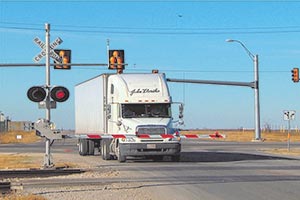Senior Reporter
FRA’s Feinberg Urges Law Enforcement, State Agencies to Aid in Reducing Collisions at Rail-Highway Crossings

This story appears in the April 4 print edition of Transport Topics.
Federal Railroad Administration officials in recent months have stepped up efforts to reduce what they say are preventable fatalities and injuries from train collisions with trucks and cars at U.S. highway rail-grade crossings.
FRA Administrator Sarah Feinberg is urging law enforcement and other federal agencies to aid the effort.
“Ending fatalities at railroad crossings and by trespassers is not a goal FRA can achieve with just another regulation or rule. It will take a strong commitment from everyone — law enforcement, regulators, railroads and motorists who drive over railroad track every day — and better education,” Feinberg said last month after the agency revamped its website.
While the number of fatalities related to train strikes at crossings declined 7% to 244 in 2015 from 264 in 2014, the number of injuries over the same period rose 12% to 967 from 860, according to FRA statistics.
In recent years, one of every four highway rail-grade crossing incidents on average involved either trucks or tractor-trailers, according to Operation Rescue, a nonprofit group that educates motorists and truck drivers about the dangers of railroad crossings.
However, in 2015, the number of trucks and tractor-trailer crossing incidents declined significantly, representing just 22.4% of the 2,059 total collision incidents, FRA data show. By comparison, in 1981 there were a total of 9,461 crossing incidents.
Feinberg outlined last month a list of ways law enforcement can help save lives at crossings, and she is urging state DOTs to continue to connect intersection traffic lights and railroad crossing signals. Across the United States, nearly 5,000 such railroad crossings are interconnected with traffic lights, FRA said.
FRA in February awarded nearly $10 million in grants for nine projects to upgrade the warning systems at critical crossings and close others in eight states where crude oil and other energy products are transported.
Also, Federal Highway Administration funds targeted to improve the design and safety of rail crossings will increase this year to $350 million from $220 million, FRA said.
Michael Cole, a spokesman for the agency, said rail regulators critically need help from other agencies to upgrade the design of crossings. “We regulate only what’s on the railroads’ right of way,” Cole said. “There is no single fix to this. It’s an all-of-the-above approach.”
Train collisions with large trucks are a particularly nettlesome problem, primarily because it can be difficult — or even impossible at times — for a driver to stop at a red light at an intersection beyond the crossing without a portion of the truck still hovering on the track.
“There are few things as challenging for a professional driver as staying safe around railroad crossings,” said Libby Rector Snipe, a spokeswoman for Operation Lifesaver, which receives its more than $2 million budget from railroads, FRA and FHWA.
“They need to make sure that they can fit all the way across the railroad crossing,” Snipe said. “We say, ‘If you don’t fit, don’t commit.’ ”
In fact, a 2013 joint rule of the Federal Motor Carrier Safety Administration and Pipeline and Hazardous Materials Administration prohibits truck drivers from entering a highway rail-grade crossing unless there is enough space to drive completely through the crossing without stopping.
But Snipe added, “Sometimes, if they’re in a traffic situation, it can be hard to gauge whether they can get all the way through the crossing before a gate may come down.”

